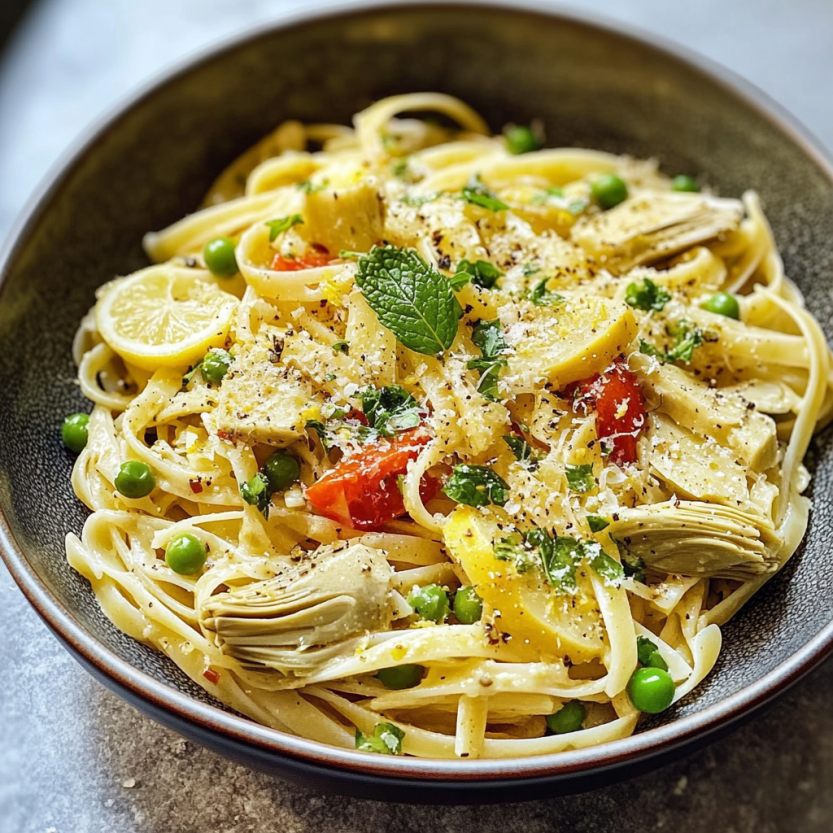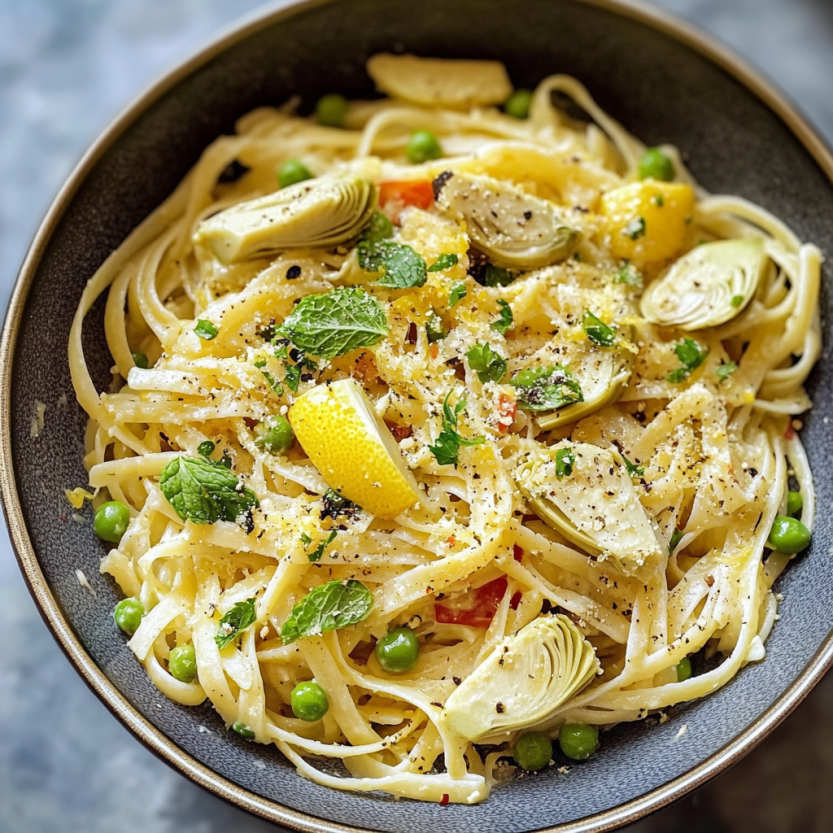 Bookmark
Bookmark
This one-pot pasta combines the essence of springtime with vibrant peas, tangy artichokes, and bright lemon all wrapped up in a creamy cheese coating. It's the perfect transition dish when you're ready to move away from heavy winter meals but still crave something satisfying and comforting.
I discovered this pasta during that awkward time between winter and spring when I was craving something lighter but not quite ready for cold salads. Now it's our go-to Friday night meal when we want something special without hours in the kitchen.
Ingredients
- Bucatini or spaghetti pasta: Forms the perfect base for catching all the creamy sauce in its long strands
- Fresh or frozen peas: Add sweet pops of flavor and bright green color
- Marinated artichoke hearts: Bring tangy complexity without extra work
- Unsalted butter: Creates the silky base for our sauce
- Pecorino cheese: Offers a salty sharpness that elevates the whole dish
- Fresh lemon juice: Cuts through the richness and wakes up all the flavors
- Fresh mint: Brings an unexpected herbaceous note that makes this dish memorable
- Lemon zest: Intensifies the citrus flavor without adding more liquid
- Freshly ground black pepper: Adds the perfect finishing touch of subtle heat
Step-by-Step Instructions
- Boil the Pasta:
- Cook your pasta in generously salted water until it reaches al dente texture, typically 6 to 8 minutes depending on your pasta shape. The pasta should have a slight firmness when bitten into. One minute before the pasta is finished cooking, add the peas to the same pot. This timing ensures the peas cook through but remain bright green and slightly firm.
- Reserve Cooking Water:
- Before draining everything, be sure to ladle out about half a cup of the starchy pasta water. This liquid gold contains starches from the pasta and will help create a silky sauce that clings to each strand.
- Combine with Artichokes:
- Drain the pasta and peas, then immediately add the marinated artichoke hearts to the hot colander. The residual heat will warm the artichokes without cooking them further, allowing their marinated flavor to remain intact.
- Create the Sauce:
- Return everything to the still warm pot, then add butter and Pecorino cheese. Toss continuously until the butter melts completely. The movement helps the cheese distribute evenly without clumping. Add the reserved pasta water and lemon juice, continuing to toss until a creamy coating forms around each strand of pasta.
- Finish and Serve:
- Transfer to plates and generously top with freshly chopped mint, lemon zest, and a few grinds of black pepper. Serve immediately while the sauce is at its creamiest consistency.
 Bookmark
Bookmark
The first time I made this pasta, I accidentally added too much lemon juice and worried I'd ruined it. Instead, that extra brightness against the rich cheese created the perfect contrast that my family now insists upon. Sometimes the best cooking discoveries happen by accident!
Perfect Timing Tips
Cooking pasta and creating a sauce that coats properly is all about timing. Cook your pasta until it's slightly firmer than you'd typically prefer, as it will continue cooking briefly when returned to the hot pot with the sauce components. If your sauce seems too thick, add a splash more pasta water. Too thin? Let it sit for a minute in the warm pot, stirring occasionally as it thickens.
Make It Your Own
While this recipe shines with peas and artichokes, you can easily customize based on what's available. Replace peas with blanched asparagus tips or tender fava beans in spring. Not a fan of mint? Fresh basil or flat-leaf parsley work beautifully too. For a protein boost, add flaked cooked salmon or small cooked shrimp at the final tossing stage.
 Bookmark
Bookmark
Storing and Reheating
This pasta will keep in the refrigerator for up to 3 days in an airtight container. When reheating, add a splash of water to loosen the sauce, as it will have thickened considerably. Warm gently on the stovetop over medium-low heat, stirring frequently. I recommend adding a fresh sprinkle of Pecorino and herbs after reheating to revive the flavors.
The Secret to Creaminess
The magic of this pasta lies in its creamy texture without using cream. The combination of starchy pasta water, butter and finely grated cheese creates an emulsion that coats each strand perfectly. For best results, make sure your cheese is finely grated not pre-shredded, which often contains anti-caking agents that prevent proper melting.
Frequently Asked Questions About Recipes
- → Can I use different types of pasta for this dish?
Yes! While the recipe suggests bucatini or spaghetti, any long pasta works well. Linguine, fettuccine, or even angel hair pasta would be excellent alternatives. The key is choosing a pasta that will properly hold the light, creamy sauce.
- → What can I substitute for marinated artichoke hearts?
If artichoke hearts aren't available, try sun-dried tomatoes, roasted red peppers, or sautéed asparagus for a similar tangy-savory component. Each will alter the flavor profile slightly but maintain the Mediterranean essence of the dish.
- → Is there a dairy-free alternative for the Pecorino cheese?
For a dairy-free version, use nutritional yeast or a plant-based Parmesan alternative. You may need to add a bit more salt to compensate for Pecorino's salty profile. Adding a tablespoon of olive oil can help maintain the creamy texture.
- → How can I make this dish more protein-rich?
To increase protein content, add grilled chicken, sautéed shrimp, or white beans. For vegetarian options, consider adding toasted pine nuts or walnuts which will complement the mint and lemon flavors while adding protein and a pleasant crunch.
- → Can I prepare any components of this dish ahead of time?
You can prep several elements in advance: chop the mint, zest the lemon, measure out the cheese, and prepare the artichokes. However, the pasta should be cooked just before serving for the best texture and to properly create the creamy sauce with the hot pasta water.
- → What herbs can I use instead of mint?
If mint isn't your preference, basil makes an excellent substitute and maintains the fresh spring flavor. Alternatively, fresh parsley, chives, or a combination of fresh herbs would work beautifully alongside the lemon and peas.
